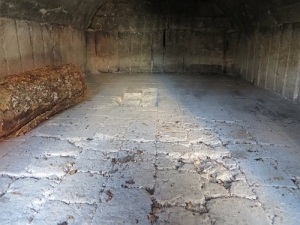Comments?
For the basics, see
- Website & Privacy Policies
- How To Get Involved
- The Role of the Park
Search options:
Department Site Map
Custodians:
 Summer 2015
Summer 2015
Dufferin Grove Park Newsletter
Comments? editor@dufferinpark.ca
Summer July/August 2015 Newsletter
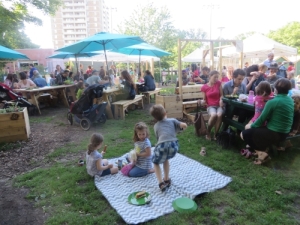 new sitting area |
Dufferin Grove Park Newsletter: Summer (July/August) 2015 This newsletter is put out by CELOS, the Centre for Local Research into Public Space. Since 2000, when this little organization began at Dufferin Grove Park, we’ve been doing what we call “theoretical and practical research” into what makes public spaces – like parks – more hospitable and more lively. We’ve been researching what works and what doesn’t, and we’ve documented a lot of what we’ve seen and done, in the fifteen years of this newsletter and on our websites. The printing of the paper version of the Dufferin Grove newsletter is currently supported by the GH Wood Foundation.
New e-mail contact for city staff: dufferinpark@toronto.ca
This newsletter and the dufferinpark.ca website are no longer a news forum for city-run programs, nor is the park’s web connection provided by CELOS any more. The City’s recreation management has activated a city internet connection for their staff: dufferinpark@toronto.ca. They plan to set up a special page on the city’s website for Dufferin Grove programs and schedules (including for the campfires), but it’s not ready yet. CELOS will continue to be involved in Dufferin Grove Park, focusing on long-time and new neighbourhood-based initiatives.
The new sitting area by the bake oven: “Dan’s Table #2”

the new tables, at Friday Night Supper
The picnic tables and benches, planters and trellises, and shade umbrellas are now in place. This was a project brokered by CELOS, and wholly funded by the GH Wood Foundation. The builder was Mike Conway, who is an artist as well as a carpenter (and it shows!). Park friend Pete Gaffney generously made his carpentry shop available to Mike. A special Saturday Night Dinner on June 20 inaugurated the new space, named “Dan’s Table #2,” in honour of Dan DeMatteis, one of the first cooks for Friday Night Supper (it began in 2003). The June 20 supper raised $830, after grocery costs were deducted. So the bake-ovens can be repaired. Those ovens are now 20 and 15 years old respectively, and they’ve developed a few trouble spots. Mike will wait until the weather cools down in the fall to climb into the smaller oven and repair the hearth bricks. The city may repair the bigger oven’s chimney, and the CELOS fund will renew part of its roof.
The story of the Dufferin Grove sandpit and adventure playground.
Sand play areas in parks are a concept that’s been around for a long time. In 1955, the Metropolitan Toronto Parks Commissioner, Tommy Thompson, told a large Garden Club meeting that he wanted to make some changes to the city’s parks. He said he “visualized large, easy-going areas with outdoor cooking equipment, plenty of toilet facilities, breathing room for family parties or large and small groups, and ready accessibility.” He also said that sand play areas for children should be big: "I passed a playground the other day in which I saw a sandbox that I suspect was twelve feet square. To me, this is an insult to the sand area concept. The time has come when we've got to get bigger in our thinking and realize that, when a group of kids want to carry out something that stimulates their imagination - and this is one of the things we should be responsible for promoting - we should be putting in a sand area half as big as this auditorium. We should be putting in the kind of sand that kids can use to build, and we should not only keep it clean every day, but make sure that it's moist enough to do something with…”
In 1993, at an April community meeting, an old-fashioned sand play area was proposed for Dufferin Grove (using a $25,000 donation from the Dufferin Mall, which also included some money for a few artists to work with the kids, and a new basketball court). Some of the immediate park neighbours were not happy about the sand pit idea. They said they didn’t want more activity in the playground, it was already noisy enough, with the wading pool and the existing playground structure. But the very hands-on Recreation director at the time, Mario Zanetti, came to the park himself, to make a pitch. He got up on a picnic table in front of the crowd and asked the opposition to give the sand play area a chance. One by one, parents from the neighbourhood came forward to the picnic table and spoke in support of his request. The immediate neighbours agreed to suspend their opposition, and the adventure playground got its start.
A sandpit was proposed because it was big, and cheap, and fast to install. To build it, we needed a City backhoe driver to dig out an area 20 x 40 feet, to about 15 inches deep, and fill it with gravel for drainage, then add four truckloads of sand piled overtop, then logs to surround it, and some branches and shovels for the kids to start working. There was ample space for this sand play area, right beside the wading pool. Simple! But then the plan began to run into trouble. The month of May came and went, and the weeks ticked by into June, and still no backhoe arrived to start making the sandpit. We learned something important. In a big city, the government might say yes, yes, yes to local ideas, but nothing might ever actually happen.
In the middle of June we realized we had to make a move to jump the gap between the park playground and the city government. We had an inspiration. We decided to write a letter to Toronto’s mayor at that time, June Rowlands, inviting her and the Dufferin Mall manager, David Hall, to the official opening of the new sandpit play area, now christened “The Big Back Yard.” We hoped that the connection between the Mall and the City would attract enough interest that somebody in the Mayor’s office would take notice of our request. The date we gave was July 5 – three weeks away.
It worked. The Mayor’s office said, yes, she would love to attend. She was fond of playgrounds, and also fond of corporate donations. We called the City Parks staff and told them that we hoped there would be something in place for the mayor to see when she came. And so the sandpit project was moved right up to the front of the line.
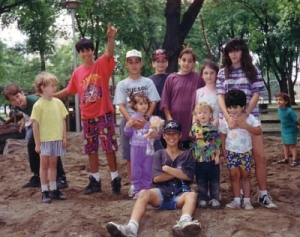
the park kids, 1994
Three weeks later, the sandpit was all ready. Four artists had been signed up to do some arts activities with the kids in the new adventure playground area. The Parks Department said they couldn’t spare a storage shed for the art supplies, so the mall threw in another $1100 and we got a carpenter to build a park-style storage shed. The lead artist, Elyse Pomerantz, painted it orange with an intricate African pattern, and the park staff got us a city padlock for it. Two days before the Mayor was due to come, we opened the storage shed padlock to find ten flats of bedding plants in the shed – a surprise gift from the Parks horticulture crew. The City’s backhoe operator, after he was done with the sandpit excavation, had already dug us a small children’s garden (his idea), around the corner from the sandpit.
So on July 5, the new play area was resplendent with its African shed, its hilled-up sandpit surrounded by giant tree trunks. The children’s garden was planted with flowers. Just before the mayor and her entourage arrived, a remote-TV vehicle drove into the park close to the sandpit and screwed its antenna as high as the trees. The park kids, a pretty rough bunch at that time, turned into the house-proud sandpit “staff,” politely offering tortilla snacks to the Mall staff and the City staff and the politicians and the cameramen.
That was the formal beginning of the Dufferin Grove sandpit.
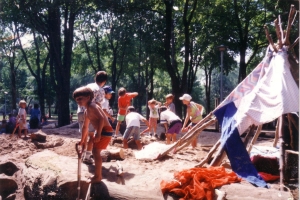
building tipi forts
At the start we only had the shovels and long poles for the kids to build with. They built tipi-forts, with pieces of cheap fabric that we brought in to cover the frames. But the forts then had to be defended, and the play sometimes became mean, focused on establishing insiders and fighting off late-comers who hadn’t been in on the fort-building.
Near the sandpit was an in-ground water outlet. Whenever the hose was set up to water the children’s flower garden, the kids would drag it over to the sandpit so they could make rivers and dams. At first we got mad at them: “keep your hands off the hose!” It took us a while to notice that the kids’ water play was more peaceful and more absorbing for them – it takes cooperation, not conflict, to make a river flow or a dam that works. We brought in shorter pieces of wood, to encourage smaller, non-fort-like structures. More and more kids came to play, and as they set up and expanded their various projects, the sandpit breached its original boundaries and eventually extended all the way down to the laneway. A proper hose with a tap on it was set up in the sandpit, and waterplay was officially allowed.
The sandpit is probably the best warm-weather element in the park, better than the bake-ovens, better than the cob cafe, better than the new reflexology footpath, maybe even better than the basketball court or the skateboarding area on the rink. It needs care, though. Sand has to be topped up when it gets low, the tap has to be easy to turn on and off, there have to be plenty of shovels and building materials, standing water has to be cleared when the dams get too high, the laneway has to be kept free of mud. Recently, the Dufferin Grove recreation staff’s attention to the sandpit has been sliding. This is partly because staff tend to be assigned tasks that focus on money-generating activities associated with food sales. Activities that don’t make money can become a bit orphaned. Building materials have dwindled as they bio-degrade, so the older kids for whom the sandpit was installed are bored, and the little kids are deprived of watching and learning from the older kids’ projects. Park neighbours report that at times the water keeps running even when there are no kids playing, and that the standing water is not cleared often enough, encouraging mosquitos.
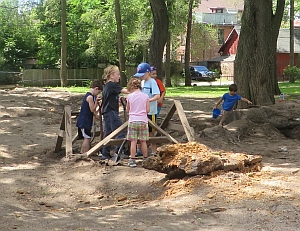
only a few building materials left
The staff’s focus will likely not be redirected soon, so the parents and caregivers who bring their kids to the sandpit need to step up. If you are the last person to leave the playground, turn off the water. Get the kids to break dams that are left with standing water. Keep play out of the laneway.
And the most important thing: PARENTS, PLEASE BRING MORE BUILDING MATERIALS. This does NOT mean plastic – kids have too much plastic already. But spare wooden boards or 2x4’s or railway ties or poles in your garage or back yard would find a much better use at the park, and fire the kids’ imagination. With staff help, you can even drive your load right into the park (5 mph with flashers on, a person walking in front of the vehicle to make sure the way is clear). It’s time to give the sandpit a boost.
WHAT HAPPENED NEXT:
Some people brought in 2x4's, others brought in logs, others brought in branches.
Here's the situation on Friday noon, August 7:
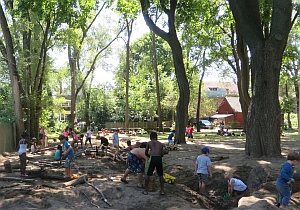
A whole lot of happy little engineers...
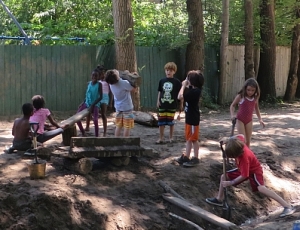
...and they even made their own teeter-totter
How to reduce “carding”
The practice by the Toronto Police of approaching random people and asking their name, address, destination, etc., and filling out a card, which is then filed in police reports, seems to be close to ending. For the record, even before carding became an official practice, it had been going on for a long time, also in Dufferin Grove Park. Police often went from picnic table to picnic table, or to any little group of youth, asking them questions – a process we called “fishing.” It became such a common event that in 2004, CELOS filed a Freedom of Information request for all such occurrences in the park between 2001 and 2004. We found that 58.5 percent of the almost 500 reports which we got through Freedom of Information had no valid (that is, lawful) reason for the stops, i.e. the reason given for the questioning was either “loitering” or a there was blank in that column. The cards of course did not specify race, but in our experience, “fishing” mostly involved people of colour.
Dufferin Grove friends and park program staff began to stand nearby when these police visits took place. Even though we were respectful and kept our distance and didn’t try to interfere, there were sometimes suggestions by police that if the observers didn’t go away, we might be charged with obstruction.
But it happened that one of the regular shinny hockey players at the rink turned out to be a lawyer who had written a whole book on the use of the “obstruct justice” charge by the police. He gave park friends and staff a little outdoor seminar on how to make it explicit to police that there was no intention of getting in the way or interfering, and therefore no occasion for police to lay a charge when observers were standing and watching.
Around 2007 the “fishing” visits slowed down in the park, and since 2010 they have been pretty rare. It may be that people stopping to stand nearby had an effect. There may be a temptation now for carding to continue unofficially even if it stops being a police policy. But when others stop and politely watch, this practice will remain under broader citizen scrutiny.
29 new trees planted in the park June 24 and 25
Sometime last winter the little honey locust tree that the park’s garden club planted near the bake oven must have accidentally been run over by a Parks vehicle. When we asked Lennox Morgan, the Parks supervisor, if the stump could be replaced, he took a walk around the park with a Forestry natural resource specialist. They decided to get a contractor to plant an additional 28 trees as well as the missing honey locust. So Dufferin Grove will be even more of a grove than it already is. They sent CELOS a google map of the park (we’ve reproduced it on the dufferinpark.ca website). Except for the soccer field, the map looks like almost solid forest. Most of the older trees are still in fine condition, especially the giant Norway maples by the playground. Maybe all that water from the sandpit tap is helping the trees…
Talking to strangers
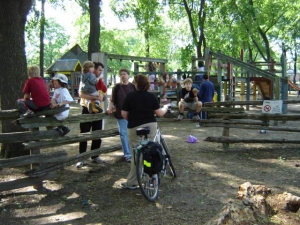
chatting over the playground fence
A city park, if it’s a pleasant destination for all sorts and ages of people, can be a kind of community centre where people can get to meet their neighbours (and in Toronto, those neighbours may hail from literally everywhere in the world – even better). Encounters are made easier by the absence of walls, so that people can watch the world go by for five minutes or five hours, without buying a ticket. And if park users are at the playground with kids or walking their dogs or skateboarding on the rink pad, they can talk to strangers who are doing the same activity, without embarrassment. One can meet interesting people, or not – there’s no commitment, such as at a social event, but there’s often surprise.
Cell phones and earphone music have reduced such contacts, but not everyone is texting or listening all the time, so it’s still possible to make new friends – and many Dufferin Grove users say they first met some of their long-lasting friends at the park. So did their children, collaborating in dam-building at the sandpit or waiting for their turn at the monkey bars or climbing in the cherry trees at Friday Night Supper.
One caution: now and then there’s a stranger who comes to Dufferin Grove but doesn’t understand that this urban park is part of everyday life for most people who come here often. An example: this past March, a mother who brought her two small children to the playground when the snow piles were still there, had an upsetting encounter with such a stranger. She had parked her sleeping toddler in his stroller beside one of the snow piles by the cob courtyard and followed his older brother to the monkey bars nearby, keeping an eye on the stroller to see when little kicking feet would announce her younger son’s waking. She suddenly saw a man bending over the stroller, and she hurried back over to see why he was there. It turned out he was on his cellphone talking to the police. Without looking around and noticing the mother nearby in the playground, he had concluded that he had just caught an incidence of child abandonment, and instantly called 911. The mother called 911 to tell them it was a false alarm, but the police said they are required by law to come anyway, and she must stay there to wait for them. When the squad car showed up 15 minutes later, the police gave the mother a lecture about staying within arm’s reach of her children, and “carded” her, presumably adding her to their list of at-risk parents. It was pretty obvious that none of the gentlemen involved in this transaction, from start to finish, had ever had to look after more than one small child (or perhaps had never looked after any children at all).
The mother, who continues to be part of the friendly kid scene at the park and whose children continue to thrive under her competent care, said she learned some things: (a) some strangers may be “risk vigilantes,” who feel that they don’t need to talk to a parent but can just diagnose a problem from a distance; (b) in such a case, it’s best to thank the stranger and leave the area before one is exposed to more foolishness – to avoid being carded for nothing. One ought not to stay and talk to such strangers, because they don’t understand….anything.
How do we get new steps and a broader path for the farmers’ market?
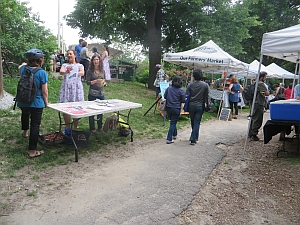
steep hill, eroding path
The weekly Thursday farmers’ market, now in its 13th year, is thriving. When it moves outside for the warm season, the market is on two levels – on the broad paved apron of the rink house building, and along the old asphalt path that leads into the park from the entrance by the stoplight intersection – down a mostly gentle-sloped hillside. The narrow path, which was put in at least thirty years ago, is starting to crumble at the edges, and the compaction caused by the market goers’ feet has eliminated the grass next to the path. Eleven years ago, now-retired Parks supervisor Sandy Straw said she’d get some broad park-style steps put into the steepest part of the hillside, to let the market users go from one part of the market to the other more comfortably, and to reduce the erosion of the hillside. But those steps are still not there, and the path needs more than ever to be redone. When word came down recently that the rink clubhouse would be renovated next year for $250,000, market manager Anne Freeman thought that the project could perhaps include the path being repaved and broadened, with permeable stone, and the steps being put in. But Park supervisor Lennox Morgan said that’s not how the City works – the rink house renovation project comes under Recreation, whereas anything outside of the building comes under Parks. Projects cannot be combined. Silos again!
Mr.Morgan said he would consider adding the farmers’ market-area steps and path and erosion control to the bottom of the Parks “minor capital” project list. But that might still take years. Is there a way to integrate Parks section projects with projects that come from the Recreation section? Is there a way for market users (farmers, customers, recreation staff) to get a seat at the table in downtown meeting rooms? Ideas are very welcome.
The park’s tandoor oven on the road
Three years ago long-time park friend David Rothberg donated funds to CELOS for a portable tandoor oven, the kind that’s in use in so many middle eastern countries, to make naan bread but also many other tasty dishes. For the first year we loaned the tandoor to the Thorncliffe Park Women’s Committee, to use at their weekly bazaars, but then they got their own tandoor. Now this tandoor is back with us and available for loan to other park groups. It recently travelled to a celebration at the new Regent Park, to expand the range of cooking available there besides the pizza-making in their new wood-fired oven. Dufferin Grove staffer Amna Malik has become very skilled at using the tandoor and is available to help any other park group that wants to borrow it. Tell you friends across town, if they want to get in touch.
Credits:
|
Newsletter prepared by: Jutta Mason Illustrations: Jane LowBeer Web sites: Aseel Al Najim celos.ca, cityrinks.ca, publiccommons.ca, publicbakeovens.ca |
Park phone: 416 392-0913 Park web site: www.dufferinpark.ca |



 Printer friendly version
Printer friendly version
